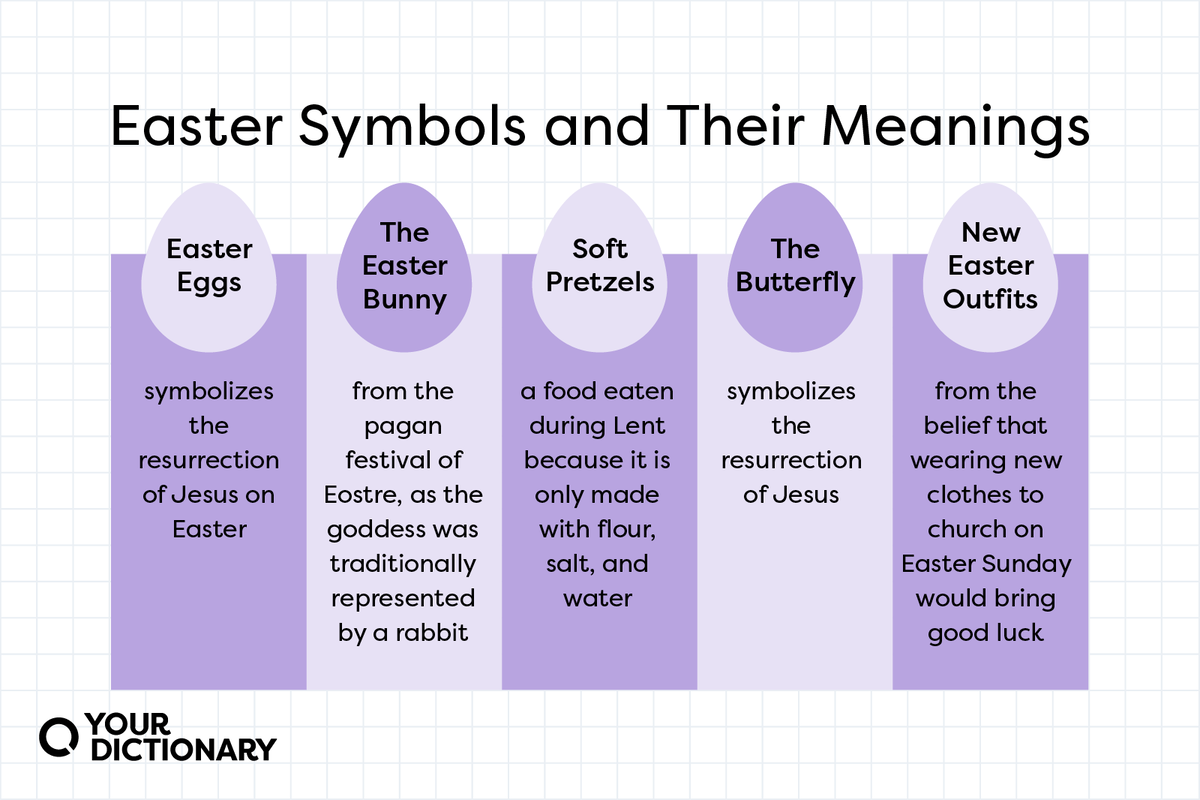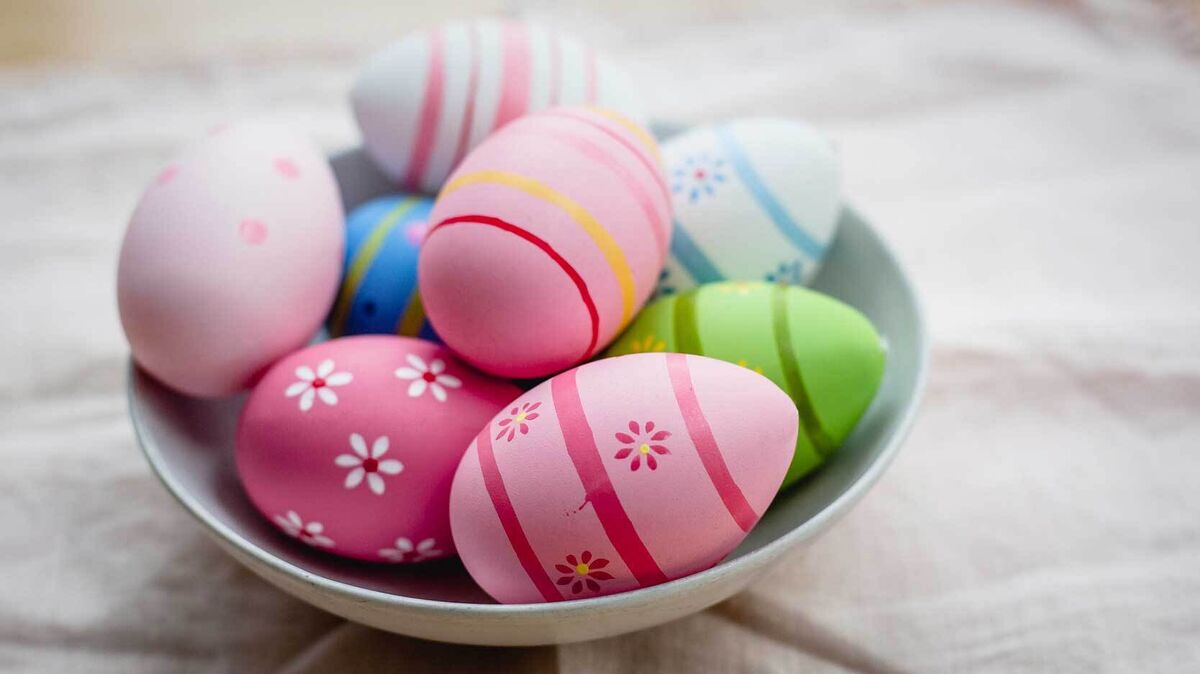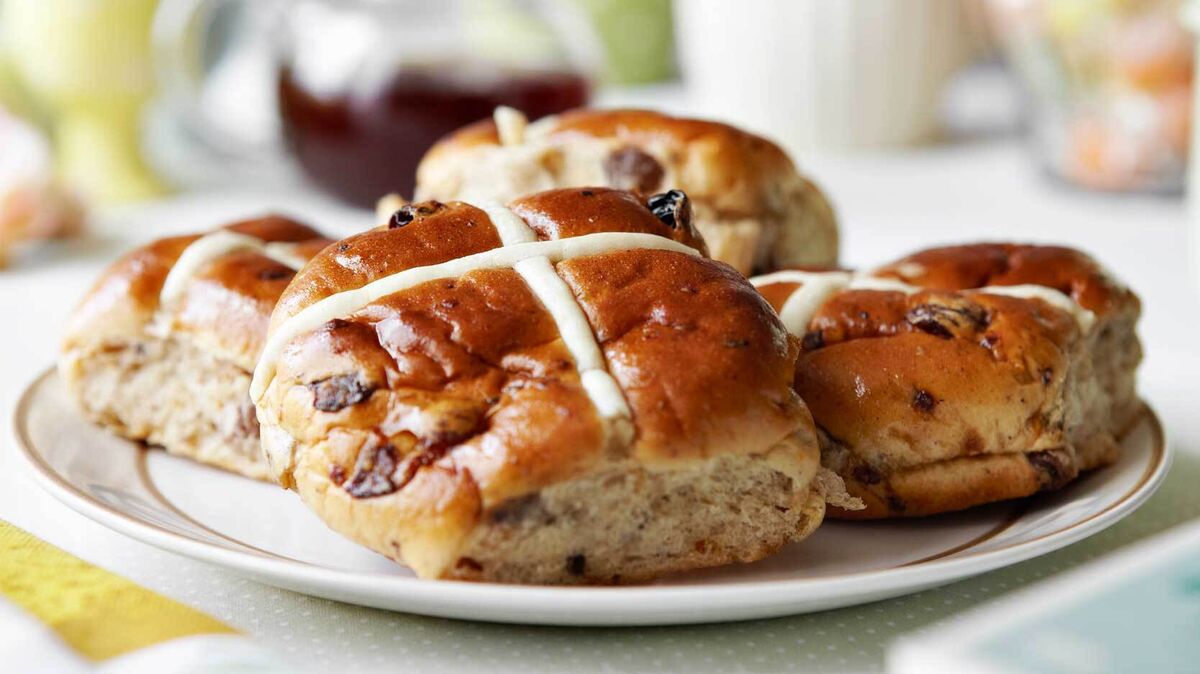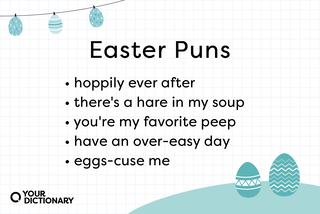
The word Easter comes from the pagan festival of Eostre, which paid tribute to the spring goddess Eostre. In fact, the month of April used to be called Eosturmonath (Eostre Month) in the Old English calendar.
Early Christianity adopted the name of this festival, which had become synonymous with springtime and rebirth, for its own Easter holiday.
Because springtime is also associated with the Jewish tradition of Passover and the Christian tradition of the resurrection of Jesus Christ, many Easter symbols have roots in pagan, Jewish, and Christian history — including Easter eggs, the Easter bunny, and even that chocolate in your Easter basket.
Easter Eggs
Originally a pagan symbol of fertility and rebirth, the Christian tradition of Easter eggs came to symbolize the resurrection of Jesus on Easter. The eggshell symbolizes the tomb in which Jesus’s body was placed; opening the egg represents his rising from the dead.
Additionally, early Christians who celebrated Lent would not eat eggs for the 40 days before Easter — so delicious eggs on Easter morning was an especially rewarding treat.

200 Spring Words to Make Your Vocabulary Bloom
Why Do We Dye Easter Eggs?
In the early Christian church (and in many Orthodox traditions today), the eggs were dyed red to symbolize the blood of Jesus during the resurrection.
As the tradition continued, Christians would paint different scenes from the Bible on the eggs, inspiring different Easter egg designs.

Easter Egg Hunts
Another custom involving Easter eggs was the Easter egg hunt — which also represented the resurrection of Jesus. Christians would hide dyed eggs for their children to find, symbolizing the search for Jesus’s body after the crucifixion.
Today, children typically search for plastic eggs filled with candy rather than cooked eggs, but the source of the tradition is the same.
Fast Fact
Easter egg is also a term for a hidden feature or image in a video game, movie, or show.
If you spot a character from your favorite movie in the corner of a totally different movie, congratulations! You’ve just spotted an Easter egg.
The Easter Bunny
So if eggs are such an important part of Easter, why do children get presents from the Easter bunny instead of the Easter chicken?
One theory for the origin of the Easter bunny comes from the pagan festival of Eostre, as the goddess was traditionally represented by a rabbit (another symbol of fertility due to how quickly they reproduce).
In 18th-century German folklore, the rabbit (Osterhase, or “Easter Hare”) laid eggs for children to discover on Easter morning. The tradition followed German immigrants to America, where the Easter bunny became a mainstay of American Easter mornings — religious and nonreligious alike.
Chocolate Easter Candy
Easter follows the period of Lent, which prohibits indulgences such as chocolate and sweets.
So Easter morning is the time when observers of Lent can finally have a bite of a chocolate bunny (or gooey chocolate egg, or whatever your favorite Easter treat may be).
Jellybeans
If chocolate candy isn't your thing, you may prefer all those pastel-colored jellybeans in your basket instead.
Jellybeans on Easter symbolize the holiday with their egg-like shape and their sweet flavor, signalling the end of Lent. In an egg shortage during World War I, jellybeans proved to be a delicious substitute in all those Easter baskets.
Easter Lilies
Easter lilies are often the centerpiece of Easter celebrations. Legend has it that white lilies sprung from the ground around Jesus as he spent his final hours on the cross. It is said that when his perspiration hit the ground, a lily grew in that spot.
As a result, Easter lilies are symbolic of new life as well as purity. For Easter, they symbolize Jesus' resurrection and the promise of everlasting life.
Baby Chicks
Chicks are a common symbol of Easter, as illustrated by the popularity of Peeps marshmallow candy. Because baby chicks are born by hatching from an egg, they symbolize new life and fertility, which is strongly associated both with Easter and the spring season overall.
Other baby animals are also sometimes considered to be Easter symbols.
The Lamb
The lamb symbolizes Jesus himself. According to Christian tradition, Jesus was sent to Earth to provide for the forgiveness of the sins of all mankind. On Good Friday, the day he was crucified, he was led “as a lamb to the slaughter.”
Additionally, like baby chicks and other newborn animals, the baby lamb symbolizes rebirth and new life in the spring season.
New Easter Outfits and Bonnets
New outfits for Easter are symbolic of rebirth and new life. Additionally, thanks to a long-standing superstition, many people believed that wearing new clothes to church on Easter Sunday would bring good luck for the coming year.
Elaborate Easter bonnets became part of the tradition over time. This gradually led to the tradition of church-goers parading through the streets after services ended to show off their finery.
Palm Branches
During Christian church services on Palm Sunday, the week before Easter, parishioners are provided with palm fronds that are used to ceremonially recreate Jesus' arrival in Jerusalem prior to the crucifixion.
This represents the biblical story of townspeople honoring Jesus as he rode into Jerusalem on a donkey by tossing small branches (likely including palms) and other items ahead of his path. Palms are said to symbolize victory and peace.
The Cross
The cross is among the most powerful and important religious symbols of Easter. While religious crosses can be made of different materials, a plain wooden cross is the version most symbolic of Easter.
This type of cross most accurately depicts the cross upon which Jesus was crucified and where he died, before being placed in a tomb and being resurrected three days later.
Soft Pretzels
Did you know that soft pretzels are technically an Easter food?
Legend has it that soft pretzels were created during the 7th century by a monk as food to eat during Lent. At this time, Catholics weren't allowed to eat eggs, fat, or milk during the 40-day fast for Lent. Pretzels require only flour, salt, and water.
Their shape is said to represent a common prayer position of the time (arms crossed in front with hands placed on shoulders). They are a traditional Lent food in many parts of the world, even though the fast rules have now been significantly relaxed.
Dogwood Trees
It is said that the wood of a dogwood tree was used to build the cross upon which Jesus was crucified. Even though Easter isn't at the same time every year, these trees typically bloom on or very close to Easter.
Hot Cross Buns
In many parts of the world, hot cross buns are a traditional food for Good Friday, which is the day Jesus was crucified on a cross. This day falls on the Friday immediately before Easter Sunday.
Each bun features a cross on top, which symbolizes the cross on which Jesus died. The spices included in the buns are said to be representative of the ones that were used to prepare Jesus' body for the tomb.

The Paschal Candle
The Paschal candle is lit from a new fire during Easter Vigil, which takes place at church the evening before Easter Sunday. It's a beeswax candle that is marked with the year, a cross and the Greek letters Alpha and Omega, which represent the beginning and the end.
The Paschal candle is then used to light smaller candles held by the members of the congregation to represent spreading the light of Jesus to those in attendance and beyond.
The Butterfly
Butterflies are symbols of the resurrection of Jesus. Just as butterflies emerge from a chrysalis in which they are hidden away, Jesus emerges from the tomb three days after being laid to rest in it.
They also represent the transformation the Christian faith can lead to, through the grace of God.
Facts About Easter
There’s even more to Easter than eggs, bunnies, and food!
- The date of Easter and when you celebrate it depends on if you are Eastern Orthodox or Western Orthodox. While both celebrate Easter on the Sunday following the vernal equinox full moon, these two churches used different calendars to calculate the vernal equinox. Therefore, they celebrate Easter on a different day.
- The week leading up to Easter is considered the Holy Week by Christians. This week leads up to Jesus Christ’s resurrection. The important days included in the Holy Week are Palm Sunday, Maundy Thursday, Good Friday, Holy Saturday, and Easter Sunday.
- In the Christian religion, Easter Sunday is also known as Resurrection Sunday. This is the day Christians commemorate the resurrection of Jesus.
- Easter is considered among the oldest Christian holidays. Writings about Easter can be found dating back to the 2nd century.
- According to the Guinness Book of World Records, the largest chocolate egg comes in at a whopping 15,873 lbs and stands 64 ft. tall.
- The tradition of Easter bonnets didn’t make waves in America until 1933. Easter bonnets were actually made popular by the song Easter Parade by Irving Berlin.
- When it comes to Easter bunnies, 59% of people eat the ears first, according to a study by Kathleen Yaremchunk.

50+ Easter Puns to Get Everybunny Laughing